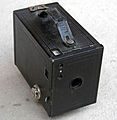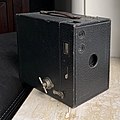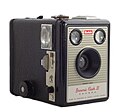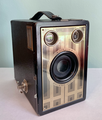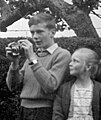Kodak Brownie
The Brownie was a series of camera models made by Eastman Kodak and first released in 1900.
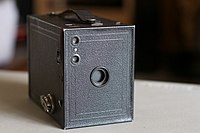 Kodak Brownie No.2 Model F (1924) | |
| Overview | |
|---|---|
| Maker | Eastman Kodak |
| Type | box camera |
| Released | February 1900 |
| Production | 1900–1986 |
| Intro price | $1 (equivalent to $37 in 2023) |
| Lens | |
| Lens | Meniscus Achromat lens |
| Sensor/medium | |
| Film format | Eastman No. 117 rollfilm |
| Film size | 2 1/4-inch square |
| Shutter | |
| Shutter | Rotary, 1/40 second |
| General | |
| Body features | Leatherette covered cardboard |
| Made in | Rochester, NY |
| Chronology | |
| Successor | No. 2 Brownie (1969) |
| References | |
| Brownie (original model) | |
It introduced the snapshot to the masses by addressing the cost factor which had meant that amateur photography remained beyond the means of many people; the Pocket Kodak for example would cost most families in Britain nearly a whole month's wages.
The Brownie was a basic cardboard box camera with a simple convex-concave lens that took 2+1⁄4-inch square pictures on No. 117 roll film. It was conceived and marketed for sales of Kodak roll films. Because of its simple controls and initial price of US$1 (equivalent to $37 in 2023) along with the low price of Kodak roll film and processing, the Brownie camera surpassed its marketing goal.
Invention and etymology
It was invented by Frank A. Brownell for the Eastman Kodak Company. Named after the Brownie characters popularised by the Canadian writer, Palmer Cox, the camera was initially aimed at children. Over 150,000 Brownie cameras were shipped in the first year of production, and cost a mere 5 shillings in the United Kingdom. An improved model, called No. 2 Brownie came in 1901, which produced larger 3.25-by-2.25-inch (1.44:1 aspect ratio)dd photos and cost $2 and was also a huge success.

Initially marketed to children, with Kodak using them to popularise photography, it achieved broader appeal as people realised that although very simple in design and operation, the Brownie could produce very good results under the right conditions.
As they were ubiquitous, many iconic shots were taken on Brownies; on 15 April 1912, Bernice Palmer used a Kodak Brownie 2A, Model A to photograph the iceberg that sank RMS Titanic as well as survivors hauled aboard RMS Carpathia, the ship on which Palmer was travelling. They were also taken to war by soldiers but by World War I the more compact Kodak Vest Pocket Camera as well as Kodak's Autographic Camera were the most frequently used.
Another group of people that became posthumously known for their huge photo archive is the Nicholas II of Russia family, especially its four daughters (known as the OTMA sisters). They even managed to make their Brownie models to produce many panoramic 4:1 photos (see Gallery).
Having written an article in the 1940s for amateur photographers suggesting an expensive camera was unnecessary for quality photography, Picture Post photographer Bert Hardy used a Brownie camera to stage a carefully posed snapshot of 17-year-old Pat Stewart, a Tiller Girls dancer, with her friend, Wendy Clarke, sitting on railings of North Pier, Blackpool, for the cover of Picture Post.
Varieties
The cameras continued to be popular, and spawned many varieties, such as a Boy Scout edition in the 1930s. In 1940, Kodak released the Six-20 Flash Brownie, Kodak's first internally synchronized flash camera, using General Electric bulbs. In 1957, Kodak produced the Brownie Starflash, Kodak's first camera with a built-in flash.
The Brownie 127 was popular, selling in the millions between 1952 and 1967. It was a bakelite camera with a simple meniscus lens and a curved film plane to compensate for the deficiencies of the lens.[citation needed] Another model was the Brownie Cresta sold between 1955 and 1958. It used 120 film and had a fixed-focus lens.
The last official Brownie camera made was the Brownie II Camera, a 110 cartridge film model produced in Brazil for one year, 1986.
The Kodak Brownie Number 2 is a box camera that was manufactured by the Eastman Kodak Company from 1901 to 1935. There were five models, A through F, and it was the first camera to use 120 film. It also came with a viewfinder and a handle. The Brownie Number 2 was made of a choice of three materials: cardboard, costing US$2.00, aluminum, costing US$2.75, and a color model which cost US$2.50. It was a very popular and affordable camera, and many are still in use by film photographers.
Gallery
- Brownie No. 2 (1901–1935)
- Kodak Brownie No. 2A, Model A (1909-1911), used by Bernice Palmer aboard RMS Carpathia
- No. 2 Folding Autographic Brownie (1915–1926)
- Beau Brownie camera (1930–1933)
- Hawkeye Brownie Flash Model (1950–1961)
- Brownie Flash III (1957–1960)
- A Kodak Brownie Target Six-20 camera with its original box
- A Brownie Starflex camera with the cover for its finder window popped up.
- A Kodak Six-16 Brownie Junior box camera
- A Kodak Brownie Holiday Flash box camera
- Young photographer using a Brownie 127
- A panoramic photo shot with a Brownie no. 2 (perhaps with a wide-angle lens) by the Romanov family in Crimea (29 May 1916).
See also
References
Further reading
- Dowling, Stephen (5 January 2015). "The most important cardboard box ever?". Retrieved 5 January 2014., gives history of the Brownie camera line
External links

- U.S. patent 725,034 Kodak Brownie, patented by George Eastman, filed July 1900
- The Brownie Camera @ 100: A Celebration on the Kodak website
- Kodak Brownie Target Six-20: A Review
This article uses material from the Wikipedia English article Kodak Brownie, which is released under the Creative Commons Attribution-ShareAlike 3.0 license ("CC BY-SA 3.0"); additional terms may apply (view authors). Content is available under CC BY-SA 4.0 unless otherwise noted. Images, videos and audio are available under their respective licenses.
®Wikipedia is a registered trademark of the Wiki Foundation, Inc. Wiki English (DUHOCTRUNGQUOC.VN) is an independent company and has no affiliation with Wiki Foundation.
